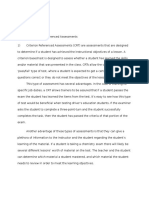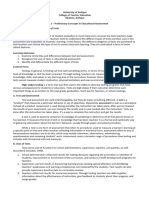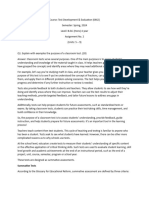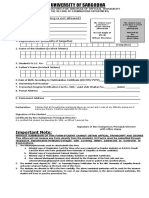Lec 3
Lec 3
Uploaded by
api-231516879Copyright:
Available Formats
Lec 3
Lec 3
Uploaded by
api-231516879Original Title
Copyright
Available Formats
Share this document
Did you find this document useful?
Is this content inappropriate?
Copyright:
Available Formats
Lec 3
Lec 3
Uploaded by
api-231516879Copyright:
Available Formats
The Similarities & Difference of Classroom Test & Standardized Achievement Test
Assessments serve several purposes, but they are most commonly used to gauge the level and depth of student learning and skill retention. Assessments can be either formative or summative. In a classroom, formative assessments are used to help teachers plan future lessons and identify areas they have to reteach or ways they must adjust their lessons. Formative assessments are usually not graded as strictly as summative assessments. Summative assessments, like standardized achievement tests, are used to gauge where students are at a particular time in relation to specific learning goals. 1. Purpose The main similarities and differences between classroom and standardized achievement tests lie in the purpose for which a particular test is administered. Classroom teachers utilize formative assessments because they are more concerned with equipping their students with certain knowledge and skills while, standardized test administrators' sole purpose is to evaluate student readiness. 2. Standardized Assessments Standardized achievement tests are used to test a students understanding of skills and knowledge in comparison to students of the same age group or educational level. The scores from these tests are used in determining a students readiness for college, graduate school and professional programs. The SAT, for example, is a well-known summative test that is used to determine a students aptitude for college. Several standardized achievement tests are given in elementary, middle and high school to provide schools with the data they need to see how a school and its students are performing in comparison with other states across the nation. 3. Similarities Classroom and standardized tests are similar in that they both test student skill and knowledge at various levels. In high school English class, for example, teachers can choose to give students a summative, standardized test that assesses understanding of grammar and usage just like a standardized achievement test. However, teachers may choose to test only the areas covered in class, while standardized achievement tests are likely to cover more ground.
www.evaeducation.weebly.com (notes by Dr. Saira)
4. Differences Some of the major differences between classroom tests and standardized tests is the allotted time, structure and content of the tests. Classroom tests can be much more individualized. A teacher may choose to test students specifically on the subject matter he or she taught in class. They may also vary the amount of time allowed for their students to take a test. In a standardized testing situation, students all take the exact same test and are given the same amount of time to take it. With the exception of accommodations for students with disabilities, standardized tests are much more structured and uniform than classroom tests. Standardized tests are created by a testing agency outside of the school environment. A classroom test is created by the teacher or perhaps a textbook company and aligned with the state standards. A standardized test is comprehensive and measures what the student has learned over a particular grading period - a semester or year. A classroom test measures what has been learned over a shorter period. With the increased emphasis on accountability in education, students are subjected more to both tests. Although there are differences between them, there are similarities also.
Decisions Regarding Administration of Test
There are state and federal mandates directing what standardized tests are taken by students and when, and at which levels those tests will be taken. The administration of a classroom test is a decision determined by the classroom teacher. Both tests are taken under the direction of school personnel and opportunities for making up in case of an absence are available for both tests. Reliability and Validity
Although the classroom teacher ensures the classroom test is a reliable and valid measure of student knowledge, this is not established via statistical testing. However, the reliability (consistency) and validity (accuracy) of a standardized test is established by a testing agency, well in advance of mandated administration. Testing Environment
The administration of a standardized test is entirely scripted, from the delivery of instructions to the end of the test. A set amount of time is allotted for testing and there are even required
www.evaeducation.weebly.com (notes by Dr. Saira)
restroom breaks for students. The atmosphere of a classroom test is more relaxed. The teacher gives directions without a script and makes decisions regarding students leaving the classroom during the test. Although these differences exists, the atmosphere in both cases is serious and students are closely monitored. Effect of the Testing Results
Standardized tests are sometimes referred to as "high-stakes testing," because the results are used for educational decision making. For instance, the results of a high school exit test, a common standardized test, could have a serious effect on a student's chance to graduate. Both tests play a part in the academic advancement of a student. However, the grade of a chapter test in biology affects a student's academic progress to a lesser extent. Assessing Group Work
All of the basic principles of assessment that apply to individual work apply to group work as well. Assessing group work has added wrinkles, however. First, depending on the objectives of the assignment, both process and product-related skills must be assessed. Second, group performance must be translated into individual grades which raises issues of fairness and equity. Complicating both these issues is the fact that neither group processes nor individual contribution are necessarily apparent in the final product. Thus, the instructor needs to find ways of obtaining that information. The following general principles should be adapted to the context of specific courses. Assess process, not just product.
If both product and process are important to you, both should be reflected in students grades although the weight you accord each will depend on your learning objectives for the course and for the assignment. Ideally, your grading criteria should be communicated to students via a rubric. This is especially important if you are emphasizing skills that students are not used to being evaluated on (such as the ability to cooperate, meet deadlines, etc.) Ask students to assess their own contribution to the team.
Have students evaluate their own teamwork skills and their contribution to the groups process using a self-assessment that focuses on the process skills you are emphasizing, e.g., respectfully
www.evaeducation.weebly.com (notes by Dr. Saira)
listening to and considering opposing views or a minority opinion; effectively managing conflict around differences in ideas or approaches; keeping the group on track both during and between meetings; promptness in meeting deadlines; and appropriate distribution of research, analysis, writing. Hold individuals accountable.
To motivate individual students and discourage the free-rider phenomenon, it is important to assess individual contributions and understanding, as well as group products and processes. In addition to evaluating the work of the group as a whole, ask individual students to demonstrate their learning. This can be done via independent write-ups, weekly journal entries, content quizzes, etc. Ask students to evaluate their groups dynamics and the contributions of their teammates.
Gauge what various group members have contributed to the group (e.g., effort, participation, cooperativeness, accessibility, communication skills) by asking team members to complete a group processes evaluation form. While this is not a fool-proof strategy (students may feel social pressure to cover for one another), combined with other factors promoting individual accountability, it can provide you with important information about the dynamics within groups and the contributions of individual members. If you are gathering feedback from external clients (for example, in the context of public reviews of students performances or creations), this feedback can also be incorporat ed into your assessment of group work. Feedback from external clients can address product (Does it work? Is it a good solution/design?) or process (based on the clients interaction with the group and its ability to communicate effectively, respond appropriately, or meet deadlines) and can be incorporated either formally or informally into the group grade.
Read more: http://www.ehow.com/info_8383042_similarities-test-standardized-achievementtest.html#ixzz2th9q44Gz alison.com/FreeOnlineCertification Read more: http://www.ehow.com/info_8383042_similarities-test-standardized-achievementtest.html#ixzz2thA3NjDF
www.evaeducation.weebly.com (notes by Dr. Saira)
You might also like
- Measurement, Assessment, Evaluation (Kizlik, B., 2012)Document43 pagesMeasurement, Assessment, Evaluation (Kizlik, B., 2012)Siti Sarah A.K86% (7)
- LorDocument1 pageLorStan Silas Miles100% (2)
- Noam Chomsky A Life of DissentDocument281 pagesNoam Chomsky A Life of Dissentcukchamu100% (3)
- Science of Reading: Editor'S NoteDocument22 pagesScience of Reading: Editor'S NoteAlex100% (3)
- 5) Case Study MethodDocument22 pages5) Case Study MethodberinimiNo ratings yet
- Diagnostic AssessmentDocument3 pagesDiagnostic AssessmentBernie Ann Lao-iNo ratings yet
- CHAPTER 1 1.2 AssessmentDocument3 pagesCHAPTER 1 1.2 Assessmentacecamero20No ratings yet
- The Pros and Cons of Standardized TestingDocument7 pagesThe Pros and Cons of Standardized TestingSher AwanNo ratings yet
- B 190313162555Document29 pagesB 190313162555CHIRANJIBI BEHERANo ratings yet
- Criterion and Referenced Based AssessmentsDocument8 pagesCriterion and Referenced Based Assessmentsapi-354763038No ratings yet
- Educational Measurement and EvaluationDocument32 pagesEducational Measurement and EvaluationFaraz Khan100% (4)
- Summary of The CourseDocument5 pagesSummary of The CourseJohn Castillo TorresNo ratings yet
- Module 5Document14 pagesModule 5Prince ZenNo ratings yet
- Assessment of Student Learning 2 - Standardized & Non-Standardized TestsDocument4 pagesAssessment of Student Learning 2 - Standardized & Non-Standardized TestsRuby Corazon EdizaNo ratings yet
- 6368897Document12 pages6368897Elvantia MarilynNo ratings yet
- 8602 Assignment AnswerDocument16 pages8602 Assignment Answernaveed shakeelNo ratings yet
- Module Diagnostic TestDocument4 pagesModule Diagnostic TestQuincy Mae MontereyNo ratings yet
- Back To Special Education and Learning Disability TermsDocument2 pagesBack To Special Education and Learning Disability TermsYviNo ratings yet
- Lessons 7 and 8, Ail1Document26 pagesLessons 7 and 8, Ail1Jonalyn RogandoNo ratings yet
- Handout 2 Test and Their Uses in The Educational AssessmentDocument5 pagesHandout 2 Test and Their Uses in The Educational AssessmentRizaldy GarciaNo ratings yet
- Assessment of LearningDocument3 pagesAssessment of LearningfloresstephaniejoycNo ratings yet
- Evaluation & TestsDocument11 pagesEvaluation & Teststuramkhan230No ratings yet
- There Are Two Categories of Test That Perform The Different FunctionsDocument5 pagesThere Are Two Categories of Test That Perform The Different FunctionsLidyaRNo ratings yet
- Difference Between Teacher Made Tests and Standardized TestsDocument11 pagesDifference Between Teacher Made Tests and Standardized TestsWendel Gabrielle L. Navarro100% (1)
- Research Report 14 Deep AssessmentsDocument8 pagesResearch Report 14 Deep AssessmentsVaalu MuthuNo ratings yet
- Measurement, Testing, Assessment and EvaluationDocument27 pagesMeasurement, Testing, Assessment and EvaluationAprilNo ratings yet
- Module 2 - Lesson 3 TYPES AND DISTINCTIONS OF TESTSDocument3 pagesModule 2 - Lesson 3 TYPES AND DISTINCTIONS OF TESTSHannah PaceteNo ratings yet
- ASSIGNMENTDocument6 pagesASSIGNMENTAmosNo ratings yet
- COURSE: Educational Measurement and Evaluation (6507) Assignment No 1Document19 pagesCOURSE: Educational Measurement and Evaluation (6507) Assignment No 1Sindhu JattNo ratings yet
- Epy Topic 11 NotesDocument9 pagesEpy Topic 11 Notesmarubegeoffrey41No ratings yet
- Module 2 - Lesson 3 Types and Distinctions of TestsDocument4 pagesModule 2 - Lesson 3 Types and Distinctions of TestsRhenzie Rizch Sican BallescasNo ratings yet
- Test Development Evaluation (6462)Document9 pagesTest Development Evaluation (6462)sarfaraz khanNo ratings yet
- Analyse Theories Principles and Models oDocument5 pagesAnalyse Theories Principles and Models oTitser JeffNo ratings yet
- Forms of AssessmentsDocument5 pagesForms of AssessmentsVincent MukukaNo ratings yet
- Test Items: ComputerDocument10 pagesTest Items: ComputerHadi KhanNo ratings yet
- Report For Psych Assessment ScriptDocument5 pagesReport For Psych Assessment ScriptAling inengNo ratings yet
- AN Assignment On Teacher Made Test (OBG)Document14 pagesAN Assignment On Teacher Made Test (OBG)Manisha ThakurNo ratings yet
- Pink Aesthetic Daily Motivation FlyerDocument5 pagesPink Aesthetic Daily Motivation FlyerMaria Faye ZaraNo ratings yet
- 8602Document15 pages8602hasnainNo ratings yet
- Pre-Assessment or Diagnostic AssessmentDocument12 pagesPre-Assessment or Diagnostic AssessmentM Noaman AkbarNo ratings yet
- Module 1 Basic Concepts and Principles in Assessing LearningDocument5 pagesModule 1 Basic Concepts and Principles in Assessing LearningLeth JoseNo ratings yet
- Report - Classifications of Assessment.Document4 pagesReport - Classifications of Assessment.jyNo ratings yet
- Lesson 1-WPS OfficeDocument5 pagesLesson 1-WPS OfficeKent MarianitoNo ratings yet
- Assessment of LearningDocument3 pagesAssessment of LearningfloresstephaniejoycNo ratings yet
- How To Make ExamsDocument5 pagesHow To Make ExamsRebecca EndayaNo ratings yet
- Ronan Article - AssessmentsDocument15 pagesRonan Article - Assessmentsapi-394750810No ratings yet
- Unit IVDocument3 pagesUnit IVsanjidazerin3939No ratings yet
- Assessment: Standardized Tests Developed by Testing Companies and Administered To LargeDocument7 pagesAssessment: Standardized Tests Developed by Testing Companies and Administered To LargeWindeeNuñalNo ratings yet
- Achievement Test ReportDocument36 pagesAchievement Test ReportHajraNo ratings yet
- Assessment Is An Integral Part of InstructionDocument2 pagesAssessment Is An Integral Part of InstructionMae MallapreNo ratings yet
- A-2 Explain The Difference Between Diagnostic, Formative, and Summative AssessmentsDocument1 pageA-2 Explain The Difference Between Diagnostic, Formative, and Summative AssessmentsDarcy StalloneNo ratings yet
- Step 1 - Previous KnowledgeDocument6 pagesStep 1 - Previous KnowledgeLina CastroNo ratings yet
- Norm-Referenced and Criterion-Referenced Tests Notes (G)Document6 pagesNorm-Referenced and Criterion-Referenced Tests Notes (G)Luthando JonasNo ratings yet
- Norm-Referenced and Criterion-Referenced Tests Notes (G)Document6 pagesNorm-Referenced and Criterion-Referenced Tests Notes (G)Luthando JonasNo ratings yet
- Norm-Referenced and Criterion-Referenced Tests Notes (G)Document6 pagesNorm-Referenced and Criterion-Referenced Tests Notes (G)Luthando JonasNo ratings yet
- Types of TestsDocument13 pagesTypes of TestsAmna NadeemNo ratings yet
- What Is Peer AssessmentDocument3 pagesWhat Is Peer AssessmentMajd HaddadNo ratings yet
- Lesson 5 AssessmentDocument5 pagesLesson 5 AssessmentJuila jean ManagaytayNo ratings yet
- Why Should AssessmentsDocument14 pagesWhy Should AssessmentsAnaly BacalucosNo ratings yet
- This Paper To Fulfill The Last Assignment With Subject: Assessment and TeachingDocument5 pagesThis Paper To Fulfill The Last Assignment With Subject: Assessment and TeachingBayu Ren WarinNo ratings yet
- Assignment: Value Added CourseDocument9 pagesAssignment: Value Added CourseParvez MalikNo ratings yet
- Testing and EvaluationDocument18 pagesTesting and EvaluationDương LệNo ratings yet
- Test and Measurement As Administrative ADocument4 pagesTest and Measurement As Administrative ALhan Nie TangguidNo ratings yet
- 1 - Testing, Assessing and TeachingDocument8 pages1 - Testing, Assessing and TeachingWilson NavaNo ratings yet
- Passing Exams with Confidence Strategies for Study Habit ImprovementFrom EverandPassing Exams with Confidence Strategies for Study Habit ImprovementRating: 5 out of 5 stars5/5 (1)
- 4 Sentence StructureDocument24 pages4 Sentence Structureapi-231516879No ratings yet
- Chapter 2Document13 pagesChapter 2api-231516879No ratings yet
- Methods of EpDocument7 pagesMethods of Epapi-231516879No ratings yet
- 1a Types of CurriculumDocument6 pages1a Types of Curriculumapi-231516879No ratings yet
- Final AssignDocument8 pagesFinal Assignapi-231516879No ratings yet
- Classro 268-270Document3 pagesClassro 268-270api-231516879No ratings yet
- Chapter 1Document35 pagesChapter 1api-231516879100% (1)
- MergedDocument15 pagesMergedapi-231516879No ratings yet
- Lec 4Document21 pagesLec 4api-2315168790% (1)
- Purposes of AssessmentDocument5 pagesPurposes of Assessmentapi-231516879No ratings yet
- Chapter 10Document35 pagesChapter 10api-231516879No ratings yet
- The Difference Between Assessment and EvaluationDocument1 pageThe Difference Between Assessment and EvaluationPn SuzAna100% (2)
- Ict Integration Strategy - FinalDocument6 pagesIct Integration Strategy - Finalapi-231516879No ratings yet
- Rock CycleDocument3 pagesRock Cycleapi-231516879No ratings yet
- Teaching Guide in Entrepreneurship: Binugao National High School Senior High School DepartmentDocument3 pagesTeaching Guide in Entrepreneurship: Binugao National High School Senior High School DepartmentRosette UngabNo ratings yet
- Creating Confluences:: Retooling Teachers For The 21 Century Teaching and LearningDocument50 pagesCreating Confluences:: Retooling Teachers For The 21 Century Teaching and LearningJulie Anne TasicNo ratings yet
- Tema 20 Oposiciones InglesDocument6 pagesTema 20 Oposiciones InglesLaura Serra LacampaNo ratings yet
- Diversity in Practice Tipsheet 2Document2 pagesDiversity in Practice Tipsheet 2api-326652861No ratings yet
- Cognitive Development of Primary SchoolersDocument16 pagesCognitive Development of Primary SchoolersEva Michelle Tolentino DatoNo ratings yet
- Correction: A Positive Approach To MistakesDocument10 pagesCorrection: A Positive Approach To MistakesnachoNo ratings yet
- Before You Start With Our Lesson, Answer First The Pre-Assessment On The ASSESSMENT SHEETS On Page 3Document4 pagesBefore You Start With Our Lesson, Answer First The Pre-Assessment On The ASSESSMENT SHEETS On Page 3Aldrin Aldrin100% (1)
- CFD - Workshop BrochureDocument2 pagesCFD - Workshop Brochurehari1405No ratings yet
- Graphic Organizer RubricDocument2 pagesGraphic Organizer Rubricapi-543816025No ratings yet
- Ordinance Bachelor of Dental Surgery (BDS) University of Delhi Faculty of Medical SciencesDocument16 pagesOrdinance Bachelor of Dental Surgery (BDS) University of Delhi Faculty of Medical SciencesFoysal SirazeeNo ratings yet
- Dinalippey Resume 1Document1 pageDinalippey Resume 1api-252092041No ratings yet
- 1-IDEA EXEMPLAR-PRACTICAL RESEARCH-1-Shares Research Experiences and KnowledgeDocument3 pages1-IDEA EXEMPLAR-PRACTICAL RESEARCH-1-Shares Research Experiences and KnowledgeGilbert Gabrillo JoyosaNo ratings yet
- Plumbing LessonDocument5 pagesPlumbing Lessonapi-25758256650% (2)
- Form 137-E (New Form For Elem)Document2 pagesForm 137-E (New Form For Elem)Lovely Joy A. Tiongco100% (1)
- Introduction To Finite Element Analysis Using SolidWorks Simulation 2012Document19 pagesIntroduction To Finite Element Analysis Using SolidWorks Simulation 2012Mohammed Abdulnaser0% (3)
- TranscriptDocument2 pagesTranscriptapi-509052055No ratings yet
- My Testimony Part 3Document8 pagesMy Testimony Part 3New Life Mission CanadaNo ratings yet
- My Teaching PhilosophyDocument5 pagesMy Teaching Philosophyapi-490624840No ratings yet
- Spec 1 Modules 1Document10 pagesSpec 1 Modules 1Ann NecdoteNo ratings yet
- Ecers PaperDocument7 pagesEcers Paperapi-254191549100% (2)
- Daily Lesson Plan in Understanding Culture Society and PoliticsDocument3 pagesDaily Lesson Plan in Understanding Culture Society and PoliticsRed AgbonNo ratings yet
- Questioning StrategiesDocument6 pagesQuestioning StrategiesMustapha AchebiNo ratings yet
- The Medicine WheelDocument5 pagesThe Medicine WheelLeo Rutherford100% (3)
- C10-1 Analytical Thinking PDFDocument49 pagesC10-1 Analytical Thinking PDFAntonakos SpirosNo ratings yet
- Bunge QuotesDocument12 pagesBunge QuotesaugustinbarriosNo ratings yet
- Important: Cutting and Overwriting Is Not AllowedDocument1 pageImportant: Cutting and Overwriting Is Not AllowedMina PariNo ratings yet








































































































